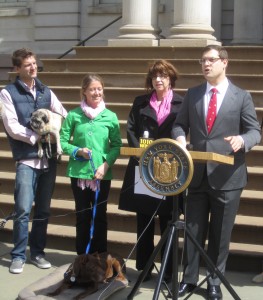The Honorable Micah Kellner, protector of shelter animals, champion of shelter volunteers, has just introduced legislation to make the “rescue dog” the official dog of New York State. Laws should not only prescribe what we expect, they should not only proscribe that which causes harm, they should set a bar of what we hope to aspire to as a society.
THE PEOPLE OF THE STATE OF NEW YORK, REPRESENTED IN SENATE AND ASSEMBLY, DO ENACT AS FOLLOWS:
Section 1. Legislative intent. Throughout history, art and literature have depicted humans in all walks of life and social strata with dogs, illustrating their widespread acceptance in everyday life. Some religions even incorporated them into their worship. Indeed, dogs have long been admired for the purity of their character traits, with military annals documenting the wartime bravery and courage of dogs in the K-9 Corps. Closer to home, our own culture is populated with examples of the well-established place dogs have found in our hearts and homes. People of all ages, but particularly the elderly and the young, enjoy their companionship. For single people, dogs offer a welcome relief from loneliness. For children, an animal in the home contributes warmth and unconditional love, and teaches responsibility and consideration for the needs of another creature. Those who suffer from disease or injury experience a therapeutic, even spiritual, benefit from their presence. Dogs do so much good for the community: they give us a sense of optimism, safeguard us from depression and loneliness, and break down the barriers that isolate us from one another. Their presence improves our health, protects us from danger, and teaches us about caring and responsibility. And they ask for so little in return.
Sadly, as many as 4 million dogs enter animal shelters in the United States each year. Over 90 percent of these dogs are savable. Most of them are simply victims of circumstance, ending up in a shelter through no fault of their own: a person moves, a couple divorces, a job is lost, someone gets ill or dies. Most of the dogs are healthy, well-behaved, and even housetrained.
Unfortunately, some people perceive rescue animals as “damaged,” concerned that the reason they are in the shelter is because something is wrong with them. Nothing could be further from the truth. But because of that perception, some people choose not to adopt. Tragically, roughly half of all dogs in shelters are killed. The deaths of these innocent animals can be prevented through adoption. Shelter and rescue animals are eager to become beloved members of a family, unconditionally loving and loyal pets, grateful for a second chance.
While some with special needs might need a little extra TLC, they can become members of loving homes, as many of the dogs saved from the horrific dog fighting operation in the Michael Vick case have proven. Adopting an animal from a shelter or rescue group eases the burden on the shelter or rescue group, enabling it to continue to serve the community by taking in other unwanted or needy animals. Generally, dogs adopted from shelters or rescue groups are neutered or spayed, thus reducing the number of homeless dogs in the state.
There are many benefits to adopting an animal from a shelter, ranging from the ownership support services that most shelters and rescues offer to the ability to adopt a dog that is already trained and housetrained. Many animal shelters and rescue organizations provide new owners with an array of material concerning their new pet’s personality, temperament, habits and other general qualities, and relating to training, common behavior problems, feeding, general care and more. In addition, there is the satisfaction of knowing that through adoption, a life has been saved.
As with the designation of other state symbols, such as the state flower or state tree, designating the rescue dog as official state dog will serve an important educational function. The state will promote humane education, providing opportunities for children in particular to learn about adopting rescued animals, as well as about the importance of measures such as spaying and neutering pets, providing them with microchip identification implants, and providing responsive pet care—all of which have been proven to reduce the number of animals arriving in shelters.
The legislature hereby finds and declares it necessary and in good policy of the state to promote and encourage the adoption of animals from animal shelters and animal rescue organizations and to recognize the services these entities provide.
Section 2. The state law is amended … to read as follows:
STATE DOG. THE RESCUE DOG SHALL BE THE OFFICIAL DOG OF THE STATE OF NEW YORK. AS USED IN THIS SECTION “RESCUE DOG” MEANS A DOG OF ANY BREED OR MIXTURE OF BREEDS RESCUED AND ADOPTED FROM AN ANIMAL SHELTER OR RESCUE GROUP LOCATED IN THE STATE.
For more information, click here.
Assembly Member Linda Rosenthal has indicated she wants to introduce legislation for an official state cat and “is thinking something feral, something that runs the streets.” Bravo!
Mr. Picklechips, a rescue dog, urges a “Yes” vote on A.B. 6681
2 have depicted humans in all walks of life and social strata with dogs,
3 illustrating their widespread acceptance in everyday life. Some reli-
4 gions even incorporated them into their worship. Indeed, dogs have long
5 been admired for the purity of their character traits, with military
6 annals documenting the wartime bravery and courage of dogs in the K-9
7 Corps.
8 Closer to home, our own culture is populated with examples of the
9 well-established place dogs have found in our hearts and homes. People
10 of all ages, but particularly the elderly and the young, enjoy their
11 companionship. For single people, dogs offer a welcome relief from lone-
12 liness. For children, an animal in the home contributes warmth and
13 unconditional love, and teaches responsibility and consideration for the
14 needs of another creature. Those who suffer from disease or injury expe-
15 rience a therapeutic, even spiritual, benefit from their presence.
16 Dogs do so much good for the community: they give us a sense of opti-
17 mism, safeguard us from depression and loneliness, and break down the
18 barriers that isolate us from one another. Their presence improves our
19 health, protects us from danger, and teaches us about caring and respon-
20 sibility. And they ask for so little in return.
21 Sadly, as many as 4 million dogs enter animal shelters in the United
22 States each year. Over 90 percent of these dogs are savable. Most of
23 them are simply victims of circumstance, ending up in a shelter through
24 no fault of their own: a person moves, a couple divorces, a job is lost,
EXPLANATION–Matter in ITALICS (underscored) is new; matter in brackets
[ ] is old law to be omitted.
LBD09997-02-1
A. 6681 2
1 someone gets ill or dies. Most of the dogs are healthy, well-behaved,
2 and even housetrained.
3 Unfortunately, some people perceive rescue animals as “damaged,”
4 concerned that the reason they are in the shelter is because something
5 is wrong with them. Nothing could be further from the truth. But because
6 of that perception, some people choose not to adopt. Tragically, roughly
7 half of all dogs in shelters are killed.
8 The deaths of these innocent animals can be prevented through
9 adoption. Shelter and rescue animals are eager to become beloved members
10 of a family, unconditionally loving and loyal pets, grateful for a
11 second chance.
12 While some with special needs might need a little extra TLC, they can
13 become members of loving homes, as many of the dogs saved from the
14 horrific dog fighting operation in the Michael Vick case have proven.
15 Adopting an animal from a shelter or rescue group eases the burden on
16 the shelter or rescue group, enabling it to continue to serve the commu-
17 nity by taking in other unwanted or needy animals. Generally, dogs
18 adopted from shelters or rescue groups are neutered or spayed, thus
19 reducing the number of homeless dogs in the state.
20 There are many benefits to adopting an animal from a shelter, ranging
21 from the ownership support services that most shelters and rescues offer
22 to the ability to adopt a dog that is already trained and housetrained.
23 Many animal shelters and rescue organizations provide new owners with an
24 array of material concerning their new pet’s personality, temperament,
25 habits and other general qualities, and relating to training, common
26 behavior problems, feeding, general care and more. In addition, there is
27 the satisfaction of knowing that through adoption, a life has been
28 saved.
29 As with the designation of other state symbols, such as the state
30 flower or state tree, designating the rescue dog as official state dog
31 will serve an important educational function. The state will promote
32 humane education, providing opportunities for children in particular to
33 learn about adopting rescued animals, as well as about the importance of
34 measures such as spaying and neutering pets, providing them with micro-
35 chip identification implants, and providing responsive pet care-all of
36 which have been proven to reduce the number of animals arriving in shel-
37 ters.
38 The legislature hereby finds and declares it necessary and in good
39 policy of the state to promote and encourage the adoption of animals
40 from animal shelters and animal rescue organizations and to recognize
41 the services these entities provide.
42 S 2. The state law is amended by adding a new section 84-a to read as
43 follows:
44 S 84-A. STATE DOG. THE RESCUE DOG SHALL BE THE OFFICIAL DOG OF THE
45 STATE OF NEW YORK. AS USED IN THIS SECTION “RESCUE DOG” MEANS A DOG OF
46 ANY BREED OR MIXTURE OF BREEDS RESCUED AND ADOPTED FROM AN ANIMAL SHEL-
47 TER OR RESCUE GROUP LOCATED IN THE STATE.

